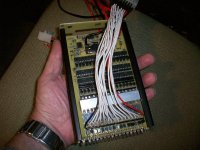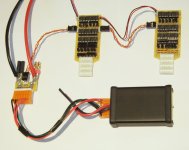SamTexas said:
This is one of the areas I don't fully understand. So "healthy" cells tend to stay pretty well balanced, but "healthy" cells age and become "less healthy". Will the Lite version still be capable of balancing those cells? In other words, is the Lite version capable of balanced charging a drastically unbalanced pack right now? How many hours does it take to balanced charge this hypothetical 6s 5Ah pack: 3.3V, 3.5V, 3.7V, 3.9V, 4.0V and 4.0V with a 5A power supply?
Yes, both the Lite, and the full Zephyr circuits will automatically balance even a grossly imbalanced pack. The difference between the two is simply the amount of time it takes. The full Zephyr circuits have shunts that will bypass about 600mA of current, while the Lite boards will bypass about 120mA of shunt current. So, it theoretically would take the full Zephyr board 1/5th the amount of time, to do a complete balance. In reality, it is probably more like a 4:1 difference. By comparison, most of the imported BMS boards cn only manage 50-60mA.
Anyway, when I say healthy cells, I mean ones that haven't lost a lot of their capacity yet. With LiPos, even as they age, the capacity numbers might start dropping off a bit, but generally, I've found this to be pretty uniform across a pack. One thing that will get even a healthy pack out-of-whack is when you discharge a pack down close to LV cutoff. The protection will save a cell from killing itself, but as the voltage gets close to the proverbial "cliff", the resting voltage will start dropping at a much quicker rate. this is where even very slight differences in capacities will show up. Anyway, when this happens, you can have some pretty significant imbalances. On the other hand, if you only discharge down to about the 15-20% level, the LiPo cells will stay pretty close.
I've had quite a bit of experience with a123 M1 LiFePO4 cells, which tend to act very much like LiPos, if you don't discharge them to LVC. Actuall, I had lots of times where a cell went ahead, and jumped off the cliff, ending up basically with a voltage under 1V. When this happened, I could recover them, by doing a very slow charge, but generally these "stressed" cells ended up losing about 10% of their capacity. From that point forward, a pack with stressed cells would still perform about the same, but it would need balancing with every charge, for sure.
As for your example, I can only make an educated guess. It looks like, with those voltages, overall the pack is about half empty. At 5A, it would probably take 1/2 hour, to 45 minutes to get to the point the shunts for the high cells start turning on. With imbalances that large, however, he shunts alone will probably not be able to hold the voltage for the high cells at 4.15V, so the upper HVC signal will start tripping, causing a cycling of the charge current. Because the full Zephyr shunts can pass more current, I'd guess this HVC cycling won't last all that long before the low cells have caught up enough that the shunt circuits alone can keep the high cells in check. Eventually, though, the Lite shunt circuits will get there as well, but how much longer, I don't know. Offhand, I'd guess maybe an hour?
In any case, both will get there eventually.

BTW, all RC balancing chargers that I'm aware of, would not charge a pack with imbalances over 200mV, or .2V. Your example is four times that.

Personally, if I had a pack that badly imbalanced, and it wasn't as a result of discharging to LVC, I'd keep a close eye on it, or take it out of commission.
-- Gary




